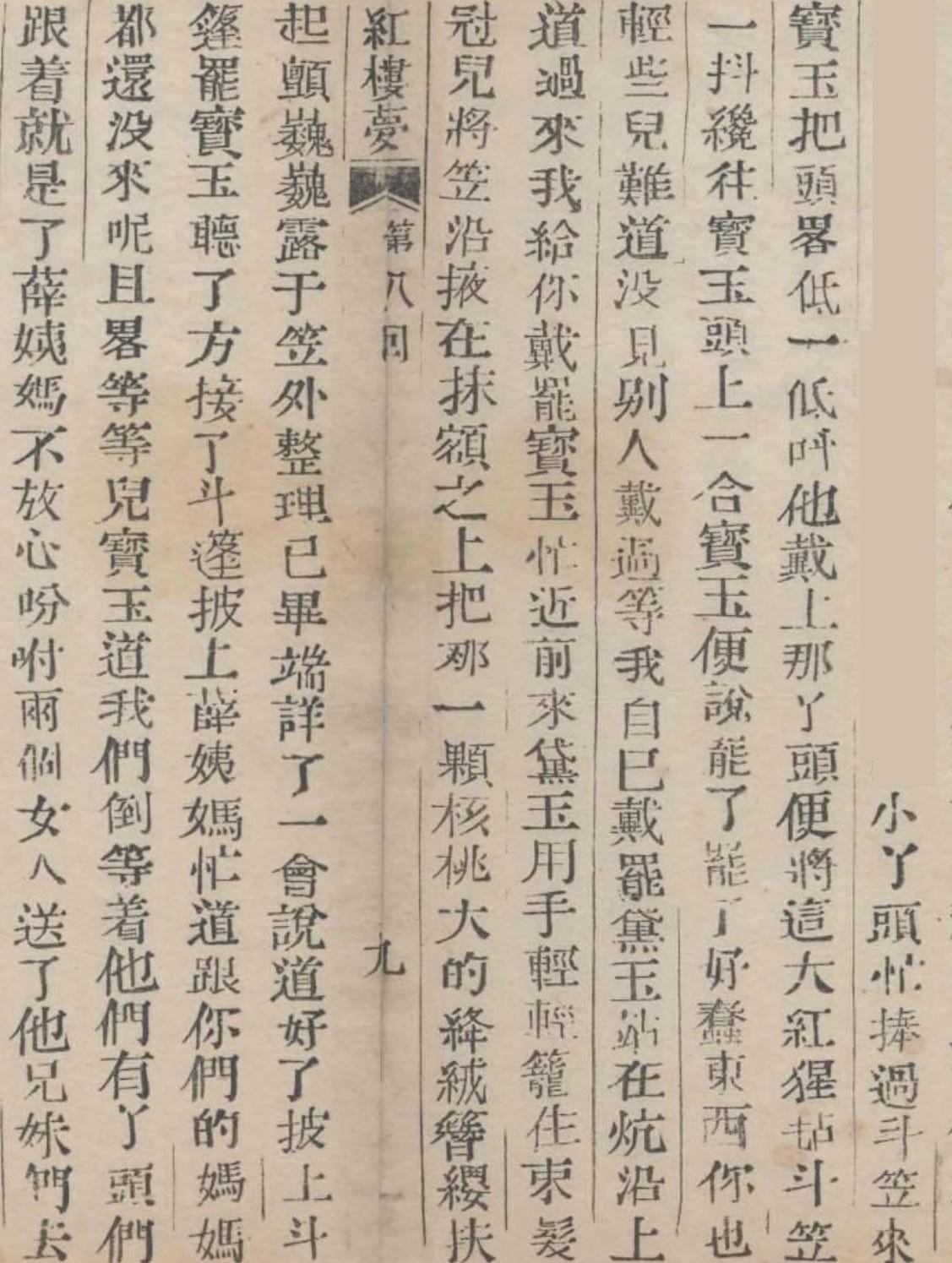The Cone Hat
This part concludes the brief section we looked at last time. A heavily inebriated Jia Baoyu leaves with Lin Daiyu. Notice the interplay between the two characters.
My Translation
After hearing they were going to leave, a young maid quickly brought over Jia Baoyu’s hat. Baoyu lowered his head slightly for her to put it on him. The maid shook the deep red felt hat for a second, and then set it directly on his head.
“That’s enough!” cried Baoyu. “You clumsy creature! You should be more gentle! Haven’t you ever seen someone wear a hat before? Let me do it myself!”
Daiyu was standing on a raised platform. “Come here,” she told him. “Let me help you put it on.”
Baoyu hurried over to her. Daiyu gently lowered the hat on top of Baoyu’s topknot holder, carefully placing it on top of his headband. She then carefully adjusted the chestnut-sized crimson tassel of the hat so that it stood upright, its trembling tip peeking out from the edge of the hat.
“Okay,” she said after she had finished adjusting it. She looked at him for a second, then said, “Now put on your cloak.”
When he heard this, he took the cloak and put it on.
“But the older maids who look after you haven’t arrived yet,” said Aunt Xue when she saw they were about to leave. “You should wait for them a moment.
“We can’t wait for them!” replied Baoyu. “The younger maids will do.”
But Aunt Xue felt uneasy, and ordered two older servants to accompany Baoyu and Daiyu.
Translation Critique
Hawkes
I think David Hawkes does a better job at explaining the clumsy actions of the maid who tried to put Baoyu’s hat on his head better than the Chinese original:
Holding up the brim of the great saucer-shaped red felt top, she jerked it up and prepared to bring it down, aiming the inside part at his crown.
The Chinese original only mentions that she shook the hat a little bit (那丫頭便將這大紅猩氈斗笠一抖) without emphasizing the awkwardness all that much. Hawkes’ addition here helps a lot with the mental image.
Yang
The Yangs use some pretty odd terminology here. The hat, which really should be thought of as a cone shaped hat, is described as a “crimson hood.” Lin Daiyu carefully places it over his “coronet” and places the edge of the hat over his “chaplet.”
“Coronet” is a pretty interesting way to translate 束髮冠兒, which really should be translated as something like “topknot.” It’s a concept we really don’t have a good English equivalent for.
“Chaplet,” meanwhile, can mean a garland for the head, which I’m guessing is the definition they were looking for. The Chinese word 抹額 is more like a headband worn by wealthy young men like Jia Baoyu.
Chinese Text
小丫頭忙捧過斗笠來。寶玉便把頭略低一低,叫他戴上。那丫頭便將這大紅猩氈斗笠一抖,才往寶玉頭上一合,寶玉便說:「罷了,罷了!好蠢東西!你也輕些兒。難道沒見別人戴過?等我自己戴罷。」黛玉站在炕沿上道:「過來,我給你戴罷。」寶玉忙近前來。黛玉用手輕輕籠住束髮冠兒,將笠沿掖在抹額之上,把那一顆核桃大的絳絨簪纓扶起,顫巍巍露於笠外。整理已畢,端詳了一會,說道:「好了,披上斗篷罷。」寶玉聽了,方接了斗篷披上。薛姨媽忙道:「跟你們的媽媽都還沒來呢,且略等等兒。」寶玉道:「我們倒等著他們!有丫頭們跟著就是了。」薛姨媽不放心,吩咐兩個女人送了他兄妹們去。
Translation Notes
斗笠 is a cone-shaped hat commonly used in Southeast Asia.
束髮冠兒 here can be kind of confusing. It seems to have been a small holder for a boy’s bound hair. It apparently was a kind of hat, which is why it’s called “冠兒.” However, I think it’s probably easier to think of it as a sort of hair holder or fastener.
笠沿 literally means the edge of the conical hat; we’d call that the “brim” today, though it’s kind of hard to think of a cone shaped hat having a brim. Daiyu tucks (掖) it over Baoyu’s headband (抹額). This headband was worn by boys to keep their hair in place and to help keep their head warm.
顫巍巍 is a really interesting adjective to use to describe a hat tassel. It means “trembling.” That’s a pretty vivid image: the chestnut-sized (核桃大) tassel (簪纓) of this felt red hat (絳絨) is quivering on top of Jia Baoyu’s head, almost like it’s nervous or scared of something.
As a verb, 端詳 means to look over carefully or scrutinize
斗篷 means a cloak or a mantle



